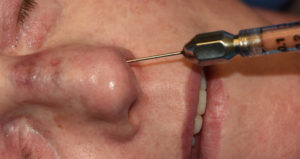Building up of the nose is a frequent objective of many Asian rhinoplasties. There are numerous materials and techniques to achieve nasal augmentation of which the patient’s own cartilage and synthetic implants are the mainstays. While both can be effective neither is perfect and each has its own distinct disadvantages.
Injected fat has now been used all over the body as a means of soft tissue augmentation. It has been used in very small sites like the earlobes to large areas like the buttocks. Injected fat has shown that it is capable of surviving in all of these sites. This raises the question of whether it could also be effective for augmentation rhinoplasty.
In the June 2016 issue of the Aesthetic Surgery Journal, an article entitled ‘Microautologous Fat Transplantation for Primary Augmentation Rhinoplasty: Long-Term Monitoring of 198 Asian Patients’ was published. Nearly 200 patients underwent primary augmentation rhinoplasty with injectable fat grafting. Fat was harvested and processed in the typical fashion by liposuction and centrifugation. Small drops of purified fat were injected into the nasal dorsum using a specialized injection gun. Patient satisfaction was assessed on a 5-point scale and aesthetic outcomes analyzed using before and after pictures.
The average operating time for the fat injections was around 30 minutes. Patients underwent anywhere from 1 to 3 fat grafting sessions. The mean volume of fat injected per treatment was 3.4 mL (range of 2.0 to 5.5 mL). Patients received follow-up for an average of 19 months. Patient satisfaction was around 66% (125 of 198 patients) indicating they were pleased with the results. There were no major complications such as infection.

Dr. Barry Eppley
Indianapolis, Indiana


